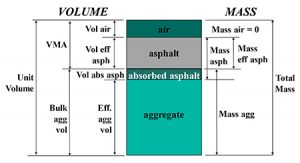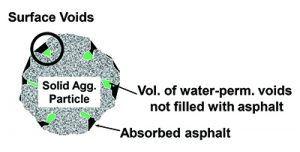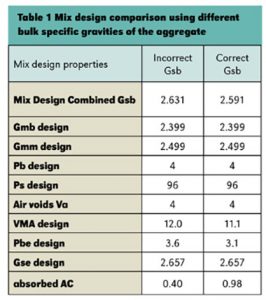By John D’Angelo, PhD, P.E.
You have just completed an asphalt mix design and are ready to do a plant trial. The mix properties all look good, air voids are on target, VMA (voids in the mineral aggregate) and VFA (voids filled with asphalt) are good. During the plant trial, the mix looks dry, but the binder content and gradation are on target. This can be a very frustrating situation.
Everything should be spot on, but the mix is just not right. If this were a high RAP (reclaimed asphalt pavement) mix the first thought would be that the RAP binder content is low, or the RAP amount was higher. If it is not a high RAP mix the likely culprit for the dry looking mix is aggregate gravities. If the aggregate gravities are not correct all the basic mix properties will be off.
Background
Both Superpave and Marshall mix design are based on optimizing the volume of aggregate, asphalt binder and air voids. The key here is volume not weight. While weight is used to control the amount of material metered into the mix at the asphalt plant, determining what that weight should be is based on volume. The primary items are air voids and binder volume which combine to become voids in mineral aggregate (VMA). These are all volume proportions of the mix and asphalt binder and aggregate proportions are set to optimize these volumes.
Mix Design
Mix design is the basic process of combining aggregate and asphalt binder to produce a strong durable mixture. The relationship of the volume of the mix components to the mass is shown in Figure 1. The conversion of mass to volume is done through the specific gravity of the individual components of the mix.

Specific gravity is the mass volume relationship of a material. Specific gravity is usually expressed in terms of grams per cubic centimeter or pounds per cubic foot. The problem comes in that not all aggregates have the same specific gravity. Some stone is heavier than others. The surface texture of the stone varies from one aggregate type to the next. A piece of trap rock will weigh more than a piece of limestone of the exact same size, but the amount of asphalt binder needed to coat the two will be similar even though the weights are different. To measure specific gravity of an aggregate its weight is compared to a material of a known mass-volume relationship, such as water. The aggregate is weighed in air then weighed under water and this provides a direct relationship of the weight of the aggregate to a known volume determined by the amount of water displaced. Thank you, Archimedes.
Determining the specific gravity of the aggregate seems simple and straightforward except that the aggregates are not simple shapes. Figure 2 shows a graphic of a piece of aggregate. Almost all aggregates have many voids, some which can be penetrated by water and asphalt and some that can’t. The bulk specific gravity of the stone (Gsb) includes the volume of the stone and the surface voids. This is where errors come into the calculations. If the voids are not determined properly the specific gravity of the aggregate could be much higher or lower than reported. When this happens the volumetric calculations for the mix could be off.

Identifying when there are problems with aggregate gravities can be very difficult. If the aggregate gravities are actually lower than those used in the volumetric calculations the effective binder content and VMA would be lower than reported. This can be seen in some sample calculations of mix properties using inaccurate and accurate bulk specific gravities of the aggregate.
The data in Table 1 shows the measured properties for one mix design. The only difference between the two columns is the bulk specific gravity of the aggregate. This data is from an actual 25-mm base mix design used for paving. The original mix design used the incorrect Gsb of 2.631. Using this incorrect Gsb the VMA meets the minimum requirements of 12 percent with absorbed asphalt binder of 0.4 percent. When the mix components were checked it was determined that the actual Gsb, of the aggregate was lower at 2.591. With the change in Gsb the VMA was reduced to 11.1 percent and the amount of absorbed asphalt binder in the aggregate increased to 0.98 percent. For this comparison, only the Gsb changed the measured mix properties of mix maximum specific gravity and bulk specific gravity of the compacted mix were the same.

The comparison of the mix properties of the same compacted mix design specimens with different bulk specific gravities of the aggregate shows how critical it is to have the correct data. The difference of only 0.041 in the Gsb values makes a difference of almost 1 percent in VMA and a reduction in the effective binder content from 3.6 percent down to 3.1 percent, a loss of 0.5 percent binder in the mix. The mix looks very old and dried out. It does not look like a new pavement. The surface is already starting to show some surface cracking. The low binder content and VMA can have very negative effects on fatigue performance and durability.
Mixtures with low binder contents are known to have shortened lives with increased cracking. The lower binder content can affect the compactibility of the mix. The mix may become very difficult to compact during placement. Issues with high in-place air voids may occur. The high in-place air voids will further reduce the durability and life of the pavement. This may also increase the roughness on the pavement surface. This example shows the issue when the actual aggregate gravities are lower than used in the volumetric calculations. The opposite can also happen if the gravities are higher. When this happens a whole different set of issues can occur. When the actual aggregate gravities are higher than used in the mix design calculations the reported VMA will be lower than actual. This may cause problems just getting the mix design to meet minimum requirements. The effective binder content would be higher than reported and this could reduce the stiffness of the mix possibly making it prone to rutting.
Making sure you have the right aggregate gravities is critical to determining the correct asphalt mix properties. Without the correct gravities the mix volumetrics will not be properly calculated and will make understanding why there are problems in the field difficult. The constructability and overall performance of the mix will be affected. So, run the tests more than once and if things don’t look right it may be the gravities are off.
D’Angelo is an asphalt consultant based in the Washington, D.C. area.